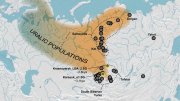Genetic tests have limits, even as tools for tracing ancient migrations. Because men don’t move around as much as women do in patriarchal societies—contrary to popular belief, says Spencer Wells, Ph.D. ’94, who heads the joint National Geographic Society-IBM Genographic Project—the Y chromosome is the best marker for charting migration patterns until it dead-ends about 60,000 to 90,000 years ago in one man who lived in Africa. To trace earlier migrations, scientists use mitochondrial DNA, which passes exclusively from mother to child. That trail leads back 200,000 years to one woman. The striking difference in the time frame, Wells notes, reflects the fact that, historically, “most women have an opportunity to reproduce, but only a few men do”—and thus a more diverse sampling of the earliest female human lineages has survived.
Wells says genetic evidence “tells us something about the who, the where, the when. But to make sense of the how and the why (which is the fun part), you have to draw in archaeology, anthropology, paleoclimatology, linguistics—all these other fields.” Climate shifts have been an important factor, though not the only one: he’s recently turned up a genetic impact of the Crusades on the gene pool of the Middle East. “We can actually trace Christian lineages in Lebanon back to source populations in Europe,” he says. “That sort of resolution has never been possible before because we didn’t have a large enough sample size.”








